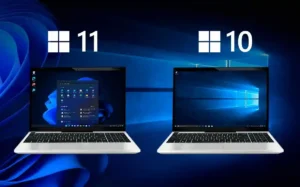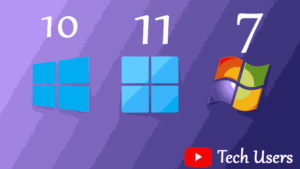Differences Between Windows 10 and Windows 11
Windows 11, released in October 2021, introduced a range of new features and design changes compared to Windows 10, which had been the primary operating system for several years. Below are the key differences between the two versions:
1. User Interface (UI) and Design
Start Menu: In Windows 11 the Start Menu is at the center while in Windows 10 the start menu is shifted to the left
Taskbar: The task bar in Windows 11 is also central with the open app icons in the middle unlike Windows 10 task bar which has the app icons on the left side.
Window Management: In windows 11, it brought about the introduction of “Snap Layouts” and “Snap Groups”, in a bid to ease multitasking which allows one to arrange and resize various windows with ease. This is not the case with windows 10 that provides minimal functional capabilities of Snap assist.
Acrylic Material: Windows 11 incorporates a design that employs certain elements of the User Interface in a semi-transparent acrylic design such as the Start Menu and the Task bar giving it a more contemporary and soft appeal.
Rounded Corners: Windows 11 uses rounded corners for all windows, app menus and other user-level devices whereas windows ten scrutinizes and uses square corners.

2. Performance Improvements
Speed and efficiency: Windows 11 has been designed for high performance, especially on the new hardware, with enhancements such as very fast wake-up from sleep, faster app launch speed, and quickly responsive system overall. Windows 10 does deliver but does not have these optimizations for performance on newer hardware.
Virtualization: WIndows 11 has more advanced system features like Hyper-V and does include the Windows Subsystem for Linux (WSL) improvements which are better than those in Windows 10.
3. System Requirements
Minimum Hardware Requirements: A few different components need to be present to install Windows 11. These components include a compatible 64-bit processor, 4GB RAM, 64GB internal storage, UEFI firmware and secure boot, tpm 2.0, and a graphics card which is compatible with DirectX 12, all of which are more than what it takes to run Windows 10.
TPM 2.0: Perhaps one of the biggest changes in the system requirements for Windows 11 is the inclusivity of TPM 2.0 (Trusted Platform Module) which is a chip that comes embedded in devices to enhance encryption and security of the whole system.
4. Support of Modern Hardware
DirectStorage: Windows 11 is integrated with DirectStorage, which enhances the gaming experience by reducing the loading time of games through direct access of GPU to the assets loading which is not supported natively by Windows 10.
AutoHDR: AutoHDR (Automatic High Dynamic Range) is an addition that serves to enhance the graphics in games that are initially designed for SDR (Standard Dynamic Range) screen displays.
Wider Compatibility for Touch and Pen Input: Windows 11 is touch and pen friendly, with improved support for such features as gestures, as well as a new virtual keyboard that has been designed from scratch.

5. Snap Assist and Multitasking
Snap Layouts & Snap Groups: Windows 11 enables users to effortlessly snap multiple windows in a variety of grid layouts with Snap Layouts. Snap Groups allow you to easily flip through a set of snapped applications. Windows 10 can snap apps, but does not have any of these advanced multitasking enhancements.
Desktops: Users can also create multiple custom virtual desktop screens on Windows 11 for various activities and each of these desktops can be customized further with different background images and layout designs. Windows 10 has virtual desktop however, Windows 11 is more enhanced in terms of usability and control.
6. Gaming Improvements
Auto HDR: As previously stated, Windows 11 gets the addition of AutoHDR support which enhances the graphics of video games.
DirectStorage: Available only on Windows 11, this innovation enables direct streaming of game assets from the SSD to GPU, hence improving load times in compatible games significantly.
Xbox Game Pass Integration: There is improved support for Xbox Game Pass in Windows 11, with the installation of the Xbox app out of the box and an overall gaming emphasis.
7. The Microsoft Store and Apps
Remodeled Microsoft Store: With Windows 11, a weighty and curated Microsoft Store creates the environment of entertainment and applications more effectively. It features a fresh look, most importantly, the structure has been changed, and better range of applications (even Android ones through the Amazon Appstore) has been supported.
Android Apps: Unlike Windows 10, Windows 11 can run android applications through the Microsoft and Amazon Appstores.
8. Strengthening the Security
TPM 2.0: To increase the security features, Windows 11 has made it mandatory to have TPM 2.0, whereas for Windows 10 it is enough to have TPM 1.2.
Secure Boot: Windows 11 uses Secure Boot which helps in ensuring that no unauthorized operating systems are loaded during startup.
Windows Hello Improvements: On top of that, Windows 11 features role-enhanced face recognition and further biometrics making security level higher than in Windows 10.
9. Issues With Cortana and Voice Control
Cortana: Unlike Windows 10 where Cortana was a central feature, Windows 11 has as it a productivity tool which is optional. Cortana was a voice command center available in Windows 10 with reminders and such being a core aspect of the operating system.
Voice Typing and Dictation: In Windows 11, voice typing is enhanced, providing voice to text dictation and also voice commands to navigate through the feature.
10. Task View and Widgets
Widgets: A fresh Widgets feature is used as an addition to Windows 11 which provides easy access to personalized news, weather, calendar and other information. A kind of Live Tiles featured by Windows 10 is the closest this version of the operating system comes to such a feature but it is not to this extent.
Task View: This new version of OS X improves on the Task View aspect by introducing new management controls of virtual desktops and enhancing the application switcher.
11. Updates and Support
Update Process: The Windows 11 has more modern update processes which are believed to be changing for the better and even faster than Windows 10 with the introduction of smaller and timely update thats suited for modern technology.
Support Lifespan: Windows 11 will have a prolonged period of support than Windows 10 that has politeness license limitations. Windows 10’s support is scheduled to end on October 14, 2025 while that of Windows 11 will take a longer time to end.
Windows Generation

12. Task Manager and Other Utilities
Task Manager: One of the features of Windows 11 is new advanced Task Manager which has a different approach and better streaming of performance graphs. When it comes to designing a task manager, window 10 has been also functional but does not have major redesign such windows 11 has.
System Tray & Quick Settings: Windows 11 has a modified System tray featuring fresh Quick Settings for Wi-Fi, Bluetooth and Volume, and new design for notification system.
13. Additional Capabilities
Focus Assist: Windows 11 introduces a better version of Focus Assist aimed at reducing distractions by better managing notifications.
Dynamic Refresh Rate: Windows 11 allows devices that support it to automatically vary the refresh rate of the screen in order to save power and improve performance.
Conclusion:
Windows 11 comes with several improvements in the user interface that are contemporary, performance increases, better tools for multitasking, and stronger security as opposed Windows 10. But it also has stiffer hardware requirements which makes it inflexible for quite older desktops. Windows 10, while being a workable and usable OS even today, does not boast almost any of the modern features present in Windows 11, particularly when it comes to the user interface, security measures, and gaming capabilities.
Tags
Windows 10
Windows 11
Windows 10 vs Windows 11
Windows 11 features
Windows 10 vs Windows 11 comparison
Windows 11 update
Windows 10 features
Windows 11 system requirements
Windows 10 upgrade to Windows 11
Windows 11 performance improvements
Windows 11 vs Windows 10 UI
Windows 10 vs Windows 11 gaming
Windows 11 taskbar differences
Windows 11 start menu vs Windows 10
Windows 10 vs Windows 11 security features
Difference between Windows 10 and Windows 11
Windows 10 vs Windows 11 features
Windows 10 vs Windows 11 UI comparison
System requirements for Windows 11
Windows 11 new features
How to upgrade from Windows 10 to Windows 11
Windows 11 vs Windows 10 performance
Windows 11 gaming features vs Windows 10
Windows 10 vs Windows 11 speed and efficiency
Is Windows 11 better than Windows 10?
Windows 10 vs Windows 11 task management
Windows 11 multitasking features vs Windows 10
Windows 11 vs Windows 10 compatibility